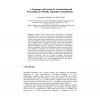Free Online Productivity Tools
i2Speak
i2Symbol
i2OCR
iTex2Img
iWeb2Print
iWeb2Shot
i2Type
iPdf2Split
iPdf2Merge
i2Bopomofo
i2Arabic
i2Style
i2Image
i2PDF
iLatex2Rtf
Sci2ools
DAGSTUHL
2001
2001
A Language and System for Constructing and Presenting Low Fidelity Algorithm Visualizations
Computer science educators have traditionally used algorithm visualization (AV) software to create graphical representations of algorithms that are later used as visual aids in lectures, or as the basis for interactive labs. Typically, such visualizations are high fidelity in the sense that (a) they depict the target algorithm for arbitrary input, and (b) they tend to have the polished look of textbook figures. In contrast, low fidelity visualizations illustrate the target algorithm for a few, carefully chosen input data sets, and tend to have a sketched, unpolished appearance. Drawing on the findings of ethnographic studies we conducted in a junior-level algorithms course, we motivate the use of low fidelity AV technology as the basis for an alternative learning paradigm in which students construct and present their own visualizations. To explore the design space of low fidelity AV technology, we present a prototype language and system derived from empirical studies in which students ...
| Added | 31 Oct 2010 |
| Updated | 31 Oct 2010 |
| Type | Conference |
| Year | 2001 |
| Where | DAGSTUHL |
| Authors | Christopher D. Hundhausen, Sarah A. Douglas |
Comments (0)

